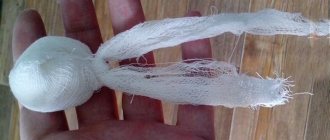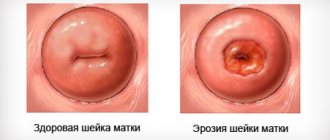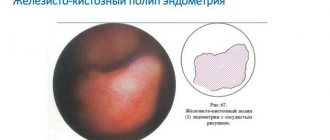Causes of colpitis
Colpitis is an inflammatory process localized on the vaginal mucosa.
It is most common among women of reproductive age, and due to certain circumstances it also develops in old age. Normally, the vaginal microflora in a healthy woman is represented mainly by vaginal bacilli of Doderlein and an extremely small amount of opportunistic microflora, the reproduction of which is suppressed by the action of vaginal bacilli. They produce lactic acid, which has a detrimental effect on pathogenic microflora. However, the number and activity of Doderlein bacilli can be suppressed with the further predominance of pathogenic infection and the development of inflammation of the vaginal walls against its background. The process can also be reversed, that is, an infection joins the primary inflammation, aggravating it. The main cause of coldpitis in the predominant number of cases is infectious microflora with further spread of inflammation, most often it is:
- Trichomonas,
- fungi of the genus Candida,
- genital herpes virus,
- cytomegalovirus,
- mycoplasma and ureaplasma,
- staphylococci and streptococci,
- intestinal flora, in particular the penetration of E. coli into the vagina,
- opportunistic pathogens - Escherichia, Proteus, Haemophilus influenzae vaginalis, etc.
However, inflammation can develop in response to mechanical damage to the vagina (later with the addition of a bacterial one), and in response to exposure to an allergen. An example would be colpitis due to rough sexual intercourse or due to the use of allergenic spermicides or intimate cosmetics.
Factors in the development of inflammation are considered to be:
- infectious microflora in the genitourinary system and intestines, from where it can easily spread to the vagina;
- disturbance of the vaginal microflora (including activation of opportunistic microorganisms), for example, due to long-term use of antibiotics;
- weakening of general and local immunity;
- hormonal imbalances - ovarian diseases, obesity, menopause, diabetes;
- microtrauma of the vaginal mucosa;
- violation of standard principles of intimate hygiene;
- development of allergies in response to the use of intimate cosmetics, contraceptives, vaginal suppositories (allergic colpitis);
- changes in the access of organic substances to the mucous membrane at any age, and more often in old age (atrophic or age-related colpitis).
Depending on the etiology and symptoms, colpitis is divided into specific and nonspecific, acute and chronic:
- specific colpitis - caused by sexually transmitted infections, the walls of the vagina are characterized by bleeding when touched;
- nonspecific colpitis - has an infectious etiology, it is often characterized by an acute form of the course with characteristic mucus secretion, itching, redness, etc.;
- acute form - mostly isolated, but extremely disturbing cases of colpitis, characterized by noticeable pain and discomfort, itching and active discharge of mucus from the vagina, and sometimes pus with blood;
- chronic form - often recurrent colpitis with minor clinical manifestations; itching and suppuration may occur less frequently, but still they indicate a complicating pathology;
The clinical picture of colpitis cannot go unnoticed by both the patient and her doctor. The characteristic symptoms are:
- mucopurulent, and sometimes bloody, discharge;
- itching and redness of the external genitalia;
- hyperemia of the vaginal mucosa;
- pain or discomfort during urination and sexual intercourse;
- periodic pain in the lower abdomen;
- general deterioration in health and decreased performance, weakness
During an in-person examination, one sees damage, swelling and hyperemia of the epithelium in the vagina, and a more detailed diagnosis allows one to confirm or refute suspicions of colpitis.
Classification
The classification of colpitis includes several types of the disease and each has its own characteristics. Below are those that are most often encountered in gynecological practice:
- trichomonas;
- candida;
- atrophic.
Trichomonas colpitis is caused by the simplest microorganisms – Trichomonas. The infection is most often transmitted sexually. You can become infected less often by sharing common household items with a sick person. If pathology is detected at an early stage, curing the disease is simple. To make a diagnosis, a doctor usually just needs to examine the patient and listen to her complaints.
Candida colpitis occurs as a result of active reproduction of pathogenic fungi of the genus Candida. Its distinctive symptoms are a curd-like white discharge and severe itching. You can become infected either from another person, simply due to a decrease in your own immunity and a change in the qualitative composition of the microflora.
Atrophic colpitis is associated with changes in hormonal levels in a woman’s body. When estrogen is not produced in the right amount, the vagina changes. Sometimes these phenomena are associated with age-related changes. Pain appears during sexual intercourse, the woman feels dryness and discomfort. Treatment of senile colpitis (senile colpitis) is carried out using hormones.
According to the nature of the course of vaginitis, two forms are distinguished:
- spicy;
- chronic.
Allergic vaginitis rarely develops. In this case, the disease is non-infectious in nature and develops as a result of contact with an allergen. Therapy is carried out after identifying the irritating factor and eliminating contact with it.
Purulent discharge appears in women only with the development of a nonspecific form of vaginitis. With specific colpitis, such phenomena, as a rule, do not occur.
How to treat colpitis?
Treatment of colpitis is a multicomponent procedure aimed at eliminating the cause of the pathology, getting rid of unpleasant symptoms, and preventing relapses and complications. It is important to destroy pathogenic microflora and restore normal flora, to modulate local and general defenses of the body.
Local treatment consists of two stages - etiotropic treatment and restoration of the natural biocenosis of the vagina. Local treatment is usually represented by:
- antibacterial therapy - mainly fluoroquinolones or combination drugs that are combined with local treatment of broad-spectrum drugs that are not absorbed into the blood and do not inhibit normal microflora;
- physiotherapy - UHF on the perineal area, UV irradiation of the vulva, SMV therapy on the vaginal area, local darsonvalization of the vagina, laser irradiation of the vulva using the contact technique;
- preparations for general strengthening effects, including vitamins, hepatoprotectors and probiotics;
- following a special diet - excluding excess fats and carbohydrates, alcohol consumption.
Local treatment involves oral or intravaginal medication. Vaginal tablets, ointment applications, suppositories, and drug-impregnated tampons may be prescribed. The specific names of the drugs are determined by the type of pathogen and other individual characteristics of a particular clinical case. In special cases, as prescribed by a doctor, hormonal therapy is acceptable and advisable.
During the treatment of colpitis, it is recommended to abstain from sexual activity or use barrier contraception (check with your doctor for specifics). After completion of the course of treatment, a second course of bacteriological tests is indicated to ensure the absence of causative agents of colpitis.
Prevention of colpitis consists of following the rules of personal hygiene and regular visits to the gynecologist (once every six months), which allows you to identify any disease at the earliest possible stages.
Bacterial vaginitis
Bacterial colpitis can be primary or secondary. The latter is divided into ascending and descending. In addition, there is nonspecific and specific vaginosis. Nonspecific colpitis of this type occurs due to the active activity of bacteria entering the vagina from the environment.
Causes of the disease:
Specific colpitis is a consequence of sexually transmitted diseases. Very often the cause is mycoplasma, chlamydia and ureaplasma. Bacterial vaginosis can occur in different ways. It can be acute, sluggish, subacute, latent, chronic and asymptomatic. Treatment depends on the form of the disease.
What diseases can it be associated with?
The occurrence of colpitis can be preceded by a variety of infectious diseases localized both in the genitourinary system or gastrointestinal tract, and throughout the body. The latter serve as a permanent source of infection and may also require antibacterial therapy, the uncontrolled implementation of which undermines the immune system and causes disruption of the normal microflora. Colpitis can be a consequence of long-term vulvitis, colitis, cystitis, urethritis.
Colpitis cannot be left unattended and ignored, including its chronic form with frequent relapses. The inflammatory process in the vagina, in the absence of adequate and timely help, tends to spread deep into the woman’s reproductive system, that is, to move to the cervical canal, the uterus itself and its appendages, and therefore is complicated by endometritis, adnexitis, cervical erosion and even infertility.
Etiotropic therapy
As with any other infectious process, the key to a successful outcome is adequate etiotropic therapy, that is, the use of antibacterial agents. At the moment, their choice is quite wide.
Nonspecific bacterial vaginitis is no exception; it is increasingly being treated with new generation antibiotics.
However, the goal of therapy remains to normalize the quantitative composition of the facultative flora.
This ensures a minimum of adverse reactions, convenience and ease of use, a reduction in the number of contraindications, and the possibility of use for concomitant diseases.
In addition, frequent use of antibiotics for chronic infection leads to changes in the composition of the patient’s own microflora and the emergence of resistant bacteria, which subsequently require adjustment of therapy.
Treatment of colpitis at home
Treatment of colpitis is usually carried out at home, that is, the patient does not need hospitalization (an exception may be women with a difficult pregnancy). However, this does not mean that the disease is insignificant and may be a reason for self-medication. A woman should take any discomfort and deviation of her condition from the norm as a signal for an unscheduled visit to her gynecologist. Careful professional diagnosis helps to prescribe adequate conservative therapy. Medications (for oral and intravaginal administration) can be supplemented by physiotherapeutic procedures (which may require a visit to a medical facility) and herbal medicine (that is, the use of folk remedies, but discussed with a professional doctor).
If a woman has a stable sex life during the period of treatment, it is necessary to use barrier contraception. It would also be useful for her partner to visit a urologist, since he may be a carrier of pathogenic microflora, which will subsequently reduce the results of treatment to zero.
The use of antibiotics is not recommended to be combined with the consumption of alcoholic beverages. Along with the use of antibiotics, the use of hepatoprotectors is indicated (to maintain liver function), and after a course of antibiotic therapy, restoration of the natural microflora of both the intestines and vagina.
Prevention
Prevention of colpitis includes the following measures:
- scheduled visit to the gynecologist every six months;
- careful adherence to intimate hygiene using delicate disinfectants;
- proper use of toilet paper to avoid infection from the rectum;
- wearing underwear made from natural fabrics;
- refusal of self-medication and uncontrolled use of hormonal drugs and antibiotics;
- maintaining a healthy lifestyle and strengthening immune forces.
Thanks to these simple methods of prevention, the risk of developing colpitis will be minimized.
Timely treatment of colpitis will avoid the unpleasant consequences of the disease. A woman who has suffered such a condition can successfully carry and give birth to a healthy child.
Watch the video:
What drugs are used to treat colpitis?
Medicines for the treatment of colpitis are determined purely by the attending physician based on the tests performed and the individual characteristics of a particular patient. Conservative treatment of colpitis involves the use of medications of various directions - this is both oral and intravaginal administration.
Vaginal treatment is performed:
- chlorhexidine - once for 5 minutes;
- citeal - daily for 10-14 days;
- instillagel - daily for 7 days;
- miramistin - twice a day;
- Vocadin solution - 3-4 times a day.
Injecting medication into the vagina (in the form of suppositories or using tampons):
- Acyclovir - cream for application to the affected area 4-5 times a day for 5-10 days;
- Bonafton - 0.5% ointment applied topically 4-6 times a day for 10 days.
- Hexicon - 1 vaginal suppository 3-4 times a day for 7-20 days;
- Ginalgin - 1 suppository at night for 10 days;
- Klion-D 100 - 1 suppository at night for 10 days;
- Clotrimazole - 1 vaginal tablet for 6 days;
- Meratin-combi - 1 suppository at night for 10 days;
- Mikozhinax - 1-2 vaginal suppositories for 6-12 days;
- Nystatin - 1 suppository at night for 7-14 days;
- Nitazol - suppositories containing 0.12 g of the drug, in the vagina 2 times a day;
- Pimafucort - cream or ointment is applied 2-4 times a day for 14 days
- Polygynax - 1-2 vaginal suppositories for 6-12 days;
- Terzhinan - 1 suppository at night for 10 days;
- Fazizhin – 1 suppository at night for 10 days;
In order to restore the natural biocenosis in the vagina:
- Acylak - 1 suppository in the vagina at night for 10 days;
- Bifidumbacterin - 1 vaginal suppository 2 times a day, 5-10 days;
- Bifikol - vaginal 5-6 doses, diluted with boiled water, 1 time per day, 7-10 days;
- Vagilak - 1 capsule into the vagina 2 times a day for 10 days;
- Lactobacterin - vaginally 5-6 doses, diluted with boiled water 1 time per day, 5-10 days.
The most effective means
Local drugs for the treatment of the disease have a targeted effect. Suppositories are inserted into the vagina, where, when dissolved, the components of the product are activated.
There are several types of suppositories that effectively cope with colpitis. The advantages of this format of medicinal products include the following:
- Suppositories do not have a negative effect on the liver.
- The rate of delivery of active substances is comparable to intramuscular injection. This is due to the concentration of a large number of blood vessels in the vagina.
- As a result of an overdose, the likelihood of developing side effects is minimal.
- The organoleptic properties of the drug are not important, since it is not used orally.
Treatment of colpitis with traditional methods
Herbal medicine is very common in the treatment of colpitis , but it is better to consult your doctor about a specific remedy, and the use of decoctions must be combined with traditional methods, which is much more effective than their exclusive use. Folk remedies should not be used as part of self-medication.
The following recipes demonstrate effectiveness:
- common flatbread root - grind 30 grams of dry root, add a liter of water and boil over low heat for 10 minutes when it cools down. strain; use for douching once a day;
- black elderberry flowers - 30 grams of dried flowers, pour ½ liter of boiling water, leave for 20 minutes, strain; use for douching once a day;
- stinging nettle inflorescences - chop 30 grams of dried inflorescences, pour in a liter of boiling water, leave for 4-5 hours, strain; use for douching once a day for 10 days;
- coltsfoot herb - pour 50 grams of coltsfoot leaves into a liter of water, boil for 5 minutes, cool and strain; use for douching once a day;
- chamomile flowers - 1 tbsp. pour dried flowers into a liter of boiling water, when it cools down, strain; use for douching once a day;
- sea buckthorn oil - you can infuse the fruits yourself in any vegetable oil (1/2 kg of berries per 1 liter of oil), or you can buy ready-made ones at the pharmacy; insert a tampon moistened with oil into the vagina for 12-14 hours;
- Scots pine buds - pour 10 grams of buds with a glass of water, keep on low heat until boiling for two minutes, cool, strain; use for douching once a day;
- sage leaves - chop 20 grams of dried leaves, pour a glass of boiling water, leave for 10 minutes, strain; use for douching once a day;
- common mother herb - chop 20 grams of dried herb, pour 2 liters of boiling water, when cool, strain; use for douching once a day;
- flowers and leaves of St. John's wort - place 500 grams of fresh plant in a dark glass bowl, pour in a liter of fresh sunflower oil, leave for 3 weeks; insert a tampon moistened with oil into the vagina for 12-14 hours.
Treatment of colpitis during pregnancy
During pregnancy, the female body is most susceptible to pathological processes, as hormonal changes occur and often a weakening of immune properties. At this time, a woman should be as attentive as possible to the health of the whole body and the reproductive system in particular.
Colpitis is one of the most common diseases to which a woman is prone during pregnancy. The inflammatory process in the vagina can be either infectious in nature or complicated by the addition of bacterial microflora. Both are completely unfavorable, and the treatment strategy is limited by the delicacy of the woman’s position.
The determination of treatment tactics, as well as a thorough diagnosis, should be carried out exclusively by a qualified professional, to whom the pregnant woman comes both for regular examinations and unscheduled for any discomfort and symptoms.
It is impossible to ignore colpitis during pregnancy, since inflammation not only causes discomfort to the expectant mother, but also threatens the health of the newborn, who is exposed to a high risk of infection during childbirth. The risk to the woman's health in this case usually consists of polyhydramnios, premature birth, and the progression of the infection extends to the amniotic fluid. In the future, untreated colpitis during pregnancy can result in endometritis and even infertility.
Therapeutic tactics are determined only after a thorough diagnosis and final diagnosis; as a rule, the basis of treatment is antibiotics, immunomodulators and physiotherapy.
The use of antibacterial therapy is significantly limited for a pregnant woman, but the doctor’s function is to select the safest and at the same time effective means. The latter, for example, include Pimafucin, Terzhinan, Vagotil, but the appropriateness of any drug is determined solely by the doctor during a face-to-face consultation.
Preference may be given to local treatment (ointments, suppositories, vaginal baths) and herbal medicine, however, the use of medicinal plants should be considered, since in this series of drugs there are also those that are not suitable for the body of a pregnant woman.
Risk factors
Certain factors can give impetus to the development of the inflammatory process:
- lack of thorough intimate hygiene;
- presence of sexually transmitted infections;
- many sexual partners;
- excessive attention to hygiene, frequent douching;
- problems with the thyroid gland;
- wearing tight synthetic underwear;
- genital injuries;
- changes in hormonal levels, for example, during pregnancy;
- menopause period;
- cancer diseases;
- undergoing radiation therapy;
- presence of HIV infection in the body;
- long-term use of antibacterial drugs;
- use of hormonal drugs;
- presence of allergies;
- lack of vitamins;
- history of abortion or miscarriage;
- diseases of the gastrointestinal tract;
- use of intrauterine contraceptives;
- unbalanced diet;
- difficult childbirth;
- ovarian dysfunction;
- undergone curettage of the uterus.
Regardless of the factors that triggered the development of colpitis, it is necessary to get rid of it as soon as possible.
Which doctors should you contact if you have colpitis?
- Gynecologist
The occurrence of suspicious symptoms should be a reason for an unscheduled visit to a gynecologist. In addition, colpitis can be diagnosed during regular (every six months) gynecological examinations. As part of a full diagnosis of colpitis, the gynecologist conducts:
- objective examination of the pelvic organs - during the period of maximum pronounced discharge without preliminary hygiene procedures for the genital organs (meaning on the very eve of the examination) and treatment of discharge;
- examination of the external genital organs and inner surfaces of the thighs (the presence of inflammatory changes, swelling, ulcerations), examination of the urethral orifice and excretory ducts of the large glands of the vestibule of the vagina, assessment of the presence of discharge on the external genitalia;
- internal gynecological examination - examination of the vagina and cervix in the speculum, with the necessary clinical and laboratory tests, which makes it possible to determine the color of the mucous membrane of the cervix and vagina, the nature of the secretion, the size and shape of the cervix, as well as the presence of a pathological process;
- colposcopy;
- bimanual and rectal examination.
- microscopy of discharge from the cervical canal, vagina and urethra for bacterial flora (most often Trichomonas, Gardnerella, gonococci and fungi);
General recommendations
In addition to suppositories, antibacterial drugs in the form of tablets or injections are used to treat colpitis.
If the disease is caused by gonococci, then taking tetracycline antibiotics is indicated. For fungal infections, Orungal or Fluconazole are prescribed in the form of suppositories. Trichomonas are eliminated with the help of Trichopolum and Metronidazole. To restore the microflora, Bifidumbacterin or Acylact is prescribed.
To speed up the recovery process and avoid relapses of the disease, doctors recommend following the following principles:
During treatment, you must wear comfortable underwear made of high-quality natural materials.
It is important to maintain hygiene standards. Washing the genitals is carried out at least twice a day
You should use daily sanitary pads before going to bed, as some of the suppositories may leak out, staining your underwear. It is advisable to include fermented milk products, vegetables and fruits in your diet. If colpitis is caused by a fungus or an infectious disease, the woman’s sexual partner should also undergo treatment. If symptoms of the disease reappear, you should not delay contacting a gynecologist.
Treatment of other diseases starting with the letter - k
| Treatment of campylobacteriosis |
| Treatment of skin candidiasis |
| Cough treatment |
| Treatment of lung cysts |
| Treatment of liver cysts |
| Treatment of pancreatic cyst |
| Treatment of splenic cyst |
| Treatment of ovarian cyst |
| Treatment of cluster headaches |
| Treatment of tick-borne encephalitis |
| Treatment of menopause |
| Treatment of colitis |
| Treatment of molluscum contagiosum |
| Treatment of Dupuytren's contracture |
| Treatment of conjunctivitis |
| Treatment of measles |
| Treatment of osteoarticular tuberculosis |
| Treatment of urticaria |
| Treatment of lichen planus |
| Treatment of rubella |
| Treatment of cryptorchidism |
| Treatment of Q fever |
The information is for educational purposes only. Do not self-medicate; For all questions regarding the definition of the disease and methods of its treatment, consult your doctor. EUROLAB is not responsible for the consequences caused by the use of information posted on the portal.











